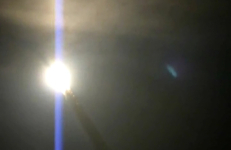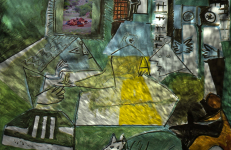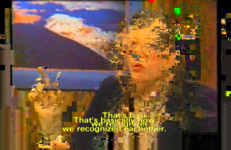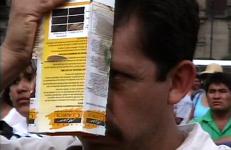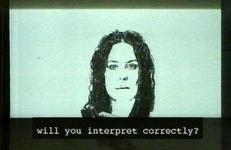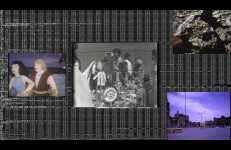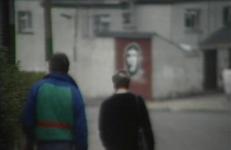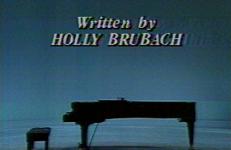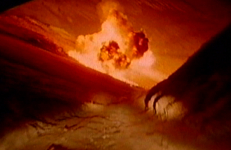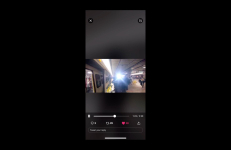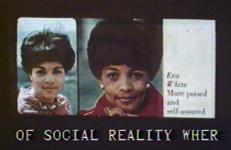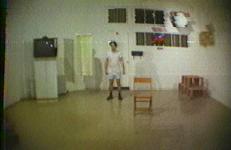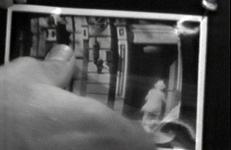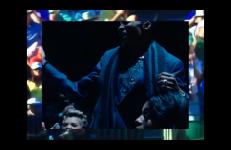A video that observes the thrill, terror, and boredom found in watching mass spectacles, and the unexpected loneliness when you miss them. This video speaks of both the power and the failure of the televised experience to bind us to one another.
Media Analysis
"We buried ten Cadillacs in a row alongside Interstate 40 (the old Route 66), just west of Amarillo, Texas; each car represented a model change in the evolution of the tail fin. This was clearly a sculptural act, but with a minimal amount of formal manipulation. Media Burn, created a year later in San Francisco, was a live performance. It was a spectacle staged for the camera culminating in the 4,000 pound Phantom Dream Car crashing through a pyramid of TV sets to the cheers of the audience of 400.
In part a remake of Hollis Frampton’s Gloria! (1979), in part a repurposing of hacked, 16-bit video game technology, The Well of Representation asks us to reconsider our fear of the liminal. Following the convergent narratives of several voices, ranging from the linearly historical to the cybernetically personal, we come to understand the journey ahead: searching from interface to interface, knowing that whatever home we find will be a collaborative compromise. One where we might live beyond our representations and finally come to say what we mean.
We have come to this place of meaning together, celebrating our un-remaindered completeness. Yet, in our wake endures a long procession of stowaways: misspoken sounds we unconsciously omit, the limitations of our alphabet, the ignored gaps of an imperfect analog, and most recently, these forgetful bits of the virtual. We celebrate the lineage of our information as we celebrate one another, not realizing that the loudest affirmations might come from these unacknowledged, unavoidable participants. With each generation, they say a little bit more, speaking a little bit louder.
"Perhaps Cuevas' most chilling work, Cinepolis forecasts an image-driven invasion of everyday life, picture-perfect and unnoticed. This alien intrusion comes in the form of a fully branded consumerscape that cheerily foists fast food along with the fantasy. Irreverent and biting, Cuevas fights back with the only weapon available--images of the enemy, and the enemy’s images."
— Steve Seid, Pacific Film Archive, 2004
This title is also available on Half-Lies: The Videoworks of Ximena Cuevas.
"code switching began as a contemporary reaction to Adrian Piper's Cornered (1988). It goes on to explore the fracturing of contemporary identity within modern culture, and the mechanisms by which individuals assign and create the cultural, racial, personal, and social identities around us. We all have codes by which we interact with and interpret others. Depending on what situation we are in, we adopt the appropriate persona to fit the occasion, constantly creating representations for others to read appropriately.
Colectivo Los Ingrávidos (Tehuacán) is a Mexican film collective founded in 2012 to dismantle the commercial and corporate audiovisual grammar and its embedded ideology. The collective is inspired by the historical avant-gardes, and their commitment to using both form and content against alienating realities. Their methods combine digital and analog mediums, interventions on archival materials, mythology, agitprop, social protests, and documentary poetry.
Colonial Transfer vindicates the eidetic chasm that produced the arrival of television in the cinema as well as the absorption, transduction and digital expansion of television and historical film archives, all linked by the negentropic outburst of a source code in trance. This is the state of ever-expanding media landscape in the post-covid quarantine. Our state of space-time.
This video takes its departure from the BBC's coverage of the killing of three IRA volunteers by British Security Forces in Strabane, a small town on the border between Northern Ireland and the Irish Republic. Interrogating television discourse, the video examines what is referred to as the British “shoot to kill” policy of planned assassination in the North.
This video takes its departure from the BBC's coverage of the killing of three IRA volunteers by British Security Forces in Strabane, a small town on the border between Northern Ireland and the Irish Republic. Interrogating television discourse, the video examines what is referred to as the British “shoot to kill” policy of planned assassination in the North.
Credits is about re-reading information. Recycling. Image-making. Wallpaper TV. Zen. Money. Labor. And of course, credits. Through all their aspects and characteristics, credits reflect the way that programs, productions and institutions select to present themselves.… Muntadas is again dealing with the 'invisible' information that lies behind mass media production and transmission.”
--Kathy Rae Huffman, Video: A Retrospective (Los Angeles: Los Angeles Institute of Contemporary Arts, 1984)
Susan Mogul's fantasies of success have always a comic, congenial twist, as in Dear Dennis, a video letter to Dennis Hopper inspired by her discovery that they share the same dentist. The central irony of this witty piece is that, despite Hopper's popular persona as an innovative, sub-cultural filmmaker and performer, the actual distance between his so-called independent" films and Mogul's experimental, non-commercial videos prevents Susan from finding any common ground from which to address Hopper other than the subject of dental work.
Like a generation of viewers, I was profoundly affected by Deliverance. But I have always been troubled by the hegemonic structures of gender proposed by Boorman and Dickey. Hence, my version is played by women: myself, Peggy Ahwesh, Jackie Goss, Su Friedrich, and Meredith Root, all experimental filmmakers who work as academics. While faithful to our respective male characters, we also play ourselves.
Starting out as equal parts authors, editors and thieves, the Disambiguation project began when two artists were invited to curate a screening together. Since they live in separate cities, Chicago and London respectively, they decided to swap and re-edit files of video and audio material from their own archives by post. Animations, pornography, songs, downloads and fragments from their own back catalogue were passed back and forth across the Atlantic to be chopped and sequenced into an exquisite corpse of swapped signals.
Starting out as equal parts authors, editors and thieves, the Disambiguation project began when two artists were invited to curate a screening together. Since they live in separate cities, Chicago and London respectively, they decided to swap and re-edit files of video and audio material from their own archives by post. Animations, pornography, songs, downloads and fragments from their own back catalogue were passed back and forth across the Atlantic to be chopped and sequenced into an exquisite corpse of swapped signals.
The Disappointment: Or, The Force of Credulity is a documentary about the search for four lost treasures buried on a single farm in Missouri. These treasures include a Spanish explorer's gold, silver from the Civil War, mysterious stone carvings, lost texts, and a wife's attempt to heal her husband and protect herself and her children. Part personal documentary and part historical essay, The Disappointment traces the patterns of cultural forgetting etched in the landscape of the Austin Farm.
Do Not Circulate, an experimental short film, attempts a structuralist and materialist approach to unraveling the entrails of a collective media memory. Paced by an essay as a relentless voiceover, the film rips footage that challenges the materiality, ownership and legal boundaries of documentation.
Rosler calls Domination and the Everyday, with its fragmented sounds, images, and crawling text, an artist-mother's This Is Your Life. Throughout this work, we hear—but do not see—a mother and small child at dinner and bedtime while a radio airs an interview with a gallerist about Californian art of the 1960s. The soundtrack moves into overdrive with feedback, a passing train, barking dogs, and a bedtime story. The visuals, all still images, are drawn from television, movies, advertising, and the family album.
Like all of Smith’s videotapes, Down in the Rec Room is based on a performance that finds Mike once again all dressed up with nowhere to go. Smith mimes along with a children’s “let’s play make believe” record, and then repeats the action—this time disco dancing along with Donny and Marie on the TV set. Down in the Rec Room continues Smith’s critique of American fantasy culture by depicting the sorry life of the average guy.
Dramatically Repeating Lawrence of Arabia is a re-edit of David Lean’s 217-minute orientalist “classic” Lawrence of Arabia into a 15-minute hallucination of repeating masculinized poses, costumes and dramatic gestures. An algorithmic structure condenses and frame-by-frame remixes the original film into a cycling of divergence, convergence and momentary mirrorings.
Baldessari has Ed Henderson examine obscure movie stills and attempt to reconstruct the films’ narratives. By removing the image from its ordinary context—in this instance the chronological flow of film time—the process of interpretation itself and the contextual meaning carried by images is examined. During these interpretative exercises, Ed Henderson urges the viewer to question where the meaning of an image lies: within the image itself or within the spectators’ reading of the image.
This title was in the original Castelli-Sonnabend video art collection.
At one point in END-LESSsestina, several men linking arms are made to walk, blindfolded, into a pool of water. We see thrashing and an expanse of blue, and finally, a lone tennis ball bobbing largely in the frame. Leading into this scene we hear a sports commentator contend, “it’s not just her out there, she’s representing America.” This line repeats itself throughout the video like a refrain; a pervasive echo of the American media’s criminalization of Serena Williams’ celebratory dance at the 2012 Olympics.
Irreverent yet poignant, The Eternal Frame is a re-enactment of the assassination of John F. Kennedy as seen in the famous Zapruder film. This home movie was immediately confiscated by the FBI, yet found its way into the visual subconscious of the nation. The Eternal Frame concentrates on this event as a crucial site of fascination and repression in the American mindset.
"The intent of this work was to examine and demystify the notion of the presidency, particularly Kennedy, as image archetype...."
— Doug Hall, 1984
Irreverent yet poignant, The Eternal Frame is a re-enactment of the assassination of John F. Kennedy as seen in the famous Zapruder film. This home movie was immediately confiscated by the FBI, yet found its way into the visual subconscious of the nation. The Eternal Frame concentrates on this event as a crucial site of fascination and repression in the American mindset.
"The intent of this work was to examine and demystify the notion of the presidency, particularly Kennedy, as image archetype...."
— Doug Hall, 1984




